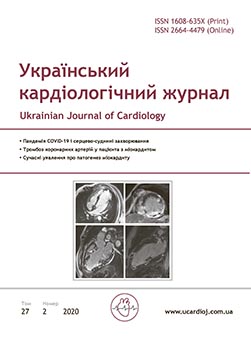First experience of using NVT Allegra system for transcatheter implantation of aortic valve and prospects for routine interventions on aortic valve in Ukraine
Main Article Content
Abstract
The aim – to present the first experience in Ukraine of using the NVT Allegra device for the procedure of transcatheter implantation of the aortic valve prosthesis to patients with high surgical risk with severe aortic stenosis.
Materials and methods. The presented clinical cases included two patients of age 90 and 80 years with severe aortic stenosis, mean transaortic blood flow gradients of 32 and 76 mm Hg and aortic valve areas of 0.4 and 0.6 cm2, respectively. Both patients were recognized as high surgical risk patients.
Results and discussion. Both patients underwent transcatheter implantation of the aortic valve prosthesis through transfemoral access. After implantation, the average gradients of the transaortic blood flow were 13 and 8 mm Hg respectively. Residual paravalvular insufficiency was mild in both cases. Second patient was implanted permanent pacemaker due to persistent complete AV block.
Conclusions. The NVT Allegra system for transcatheter implantation of the aortic valve prosthesis is a third generation device that enables successful and safe intervention of the aortic valve.
Article Details
Keywords:
References
Aksonov E., Berestovenko V., Panichkin Yu. et al. First experience of endovascular aortic valve replacement // Cardiac Surgery and Interventional Cardiology.– 2013.– Vol. 3 (12).– P. 37–40 (in Ukr).
Collas V., Philipsen T., Rodrigus I. et al. Transcatheter aortic valve implantation: review and current state of the art // EMJ. Int. Cardiol.–2014.– Vol. 1 (8).– P. 52–61.
Cuevas O. The Allegra transcatheter heart valve: European multicentre experience with a novel self-expanding transcatheter aortic valve // EuroIntervention.– 2019.– Vol. 15.– P. 71–73. doi: https://doi.org/10.4244/EIJ-D-18-00861.
Deutsch M.-A., Erlebach M., Burri M. et al. Beyond the five-year horizon: long-term outcome of high-risk and inoperable patients undergoing TAVR with first-generation devices // EuroIntervention.– 2018.– Vol. 14.– P. 41–49. doi: https://doi.org/10.4244/EIJ-D-17-00603.
Gupta T., Kolte D., Khera S. et al. The changing landscape of aortic valve replacement in the USA // EuroIntervention.– 2019.– Vol. 15.– P. e968–e974. doi: https://doi.org/10.4244/EIJ-D-19-00381.
Modolo R., Chang C., Onuma Y.H. et al. Quantitative aortography assessment of aortic regurgitation. Insight into a novel technique // Euro Intervention.– 2019.– Vol. 15.– P. e975–e988. doi: https://doi.org/10.4244/EIJ-D-19-00879.
Osnabrugge R., Mylotte D., Head S. Aortic stenosis in the elderly disease prevalence and number of candidates for transcatheter aortic valve replacement: a meta-analysis and modeling study // J. Amer. Coll. Cardiology.– 2013.– Vol. 62 (11).– P. 1002–1012.
Ross J., Braunwald E. Aortic stenosis // Circulation.– 1968.– Vol. 38 (1).– P. 61–67.

